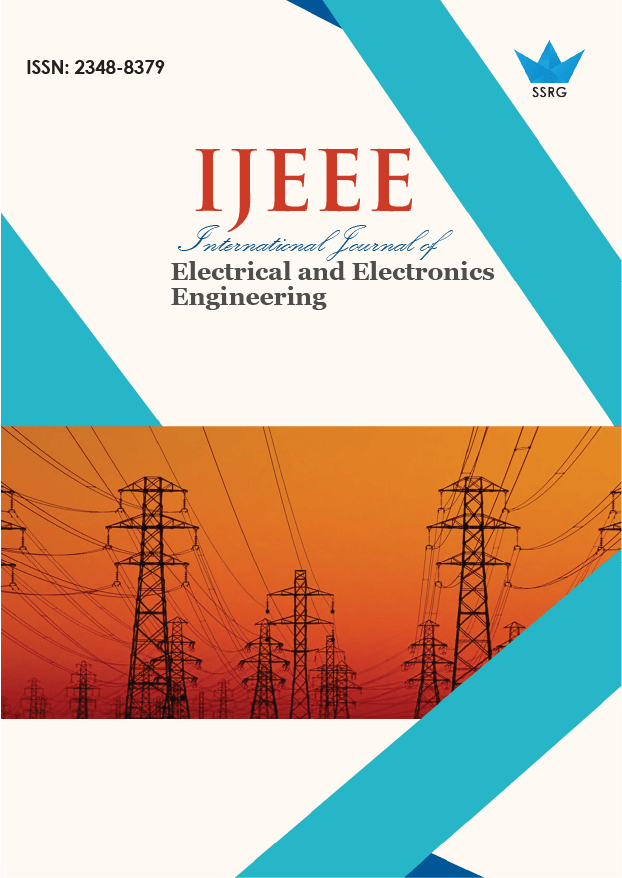IoT-Based Smart Glasses Assistance System with Facial Recognition

| International Journal of Electrical and Electronics Engineering |
| © 2024 by SSRG - IJEEE Journal |
| Volume 11 Issue 12 |
| Year of Publication : 2024 |
| Authors : Flavio Cesar Abarca Jahuira, David Cana Salas, Jesús Talavera Suarez |
How to Cite?
Flavio Cesar Abarca Jahuira, David Cana Salas, Jesús Talavera Suarez, "IoT-Based Smart Glasses Assistance System with Facial Recognition," SSRG International Journal of Electrical and Electronics Engineering, vol. 11, no. 12, pp. 287-294, 2024. Crossref, https://doi.org/10.14445/23488379/IJEEE-V11I12P126
Abstract:
Smart glasses are becoming increasingly available in the population due to their ability to provide real-time environmental information; however, the incorporation of facial recognition through the Internet of Things marks an important advance in the performance and usability of these devices. This study describes the creation of a novel Internet of Things-based human face recognition assistance system for smart glasses. The developed system uses a Raspberry Pi 4 board, an ESP32 board, two camera modules to capture and process the environment through artificial vision, and a sound module responsible for realizing the assistance system. Developing a functional prototype of smart glasses will enable visually impaired people to obtain information from others and be aware of potential environmental dangers. This system is made possible through facial recognition technology and distance estimation algorithms. In addition, this study addresses integrating the proposed system with the Internet of Things, enabling better connectivity and effective communication with other devices and services. Finally, practical tests are used to evaluate the usability and user experience of the system, as well as its accuracy in measuring distances and identifying faces of previously registered users. Studies show that the system is quite effective in assisting people with partial or total blindness and ensures that it is simple to use and intuitive in real-world scenarios.
Keywords:
Computer vision, Real-time assistance system, Smart glasses, Internet of Things.
References:
[1] Niek Zuidhof et al., “Defining Smart Glasses: A Rapid Review of State-of-the-Art Perspectives and Future Challenges from a Social Sciences’ Perspective,” Augmented Human Research, vol. 6, pp. 1-18, 2021.
[CrossRef] [Google Scholar] [Publisher Link]
[2] Dawon Kim, and Yosoon Choi, “Applications of Smart Glasses in Applied Sciences: A Systematic Review,” Applied Sciences, vol. 11, no. 11, pp. 1-21, 2021.
[CrossRef] [Google Scholar] [Publisher Link]
[3] Xinyi Wang et al., “A Survey of Face Recognition,” arXiv preprint, 2022.
[CrossRef] [Google Scholar] [Publisher Link]
[4] Guodong Guo, and Na Zhang, “A Survey on Deep Learning Based Face Recognition,” Computer Vision and Image Understanding, vol. 189, 2019.
[CrossRef] [Google Scholar] [Publisher Link]
[5] Amir Masoud Rahmani et al., “The Internet of Things for Applications in Wearable Technology,” IEEE Access, vol. 10, pp. 123579-123594, 2022.
[CrossRef] [Google Scholar] [Publisher Link]
[6] Naghmeh Niknejad et al., “A Comprehensive Overview of Smart Wearables: The State of the Art Literature, Recent Advances, and Future Challenges,” Engineering Applications of Artificial Intelligence, vol. 90, 2020.
[CrossRef] [Google Scholar] [Publisher Link]
[7] Stefan Mitrasinovic., “Clinical and Surgical Applications of Smart Glasses,” Technology and Health Care, vol. 23, no. 4, pp. 381-401, 2020.
[CrossRef] [Google Scholar] [Publisher Link]
[8] F. John Dian, Reza Vahidnia, and Alireza Rahmati, “Wearables and the Internet of Things (IoT), Applications, Opportunities, and Challenges: A Survey,” IEEE Access, vol. 8, pp. 69200-69211, 2020.
[CrossRef] [Google Scholar] [Publisher Link]
[9] Constantino Álvarez Casado et al., “Face Detection and Recognition for Smart Glasses,” International Symposium on Consumer Electronics, pp. 1-2, 2015.
[CrossRef] [Google Scholar] [Publisher Link]
[10] Wafa Mellouk, and Wahida Handouzi, “Facial Emotion Recognition Using Deep Learning: Review and Insights,” Procedia Computer Science, vol. 175, pp. 689-694, 2020.
[CrossRef] [Google Scholar] [Publisher Link]
[11] Yassin Kortli et al., “Face Recognition Systems: A Survey,” Sensors, vol. 20, no. 2, pp. 1-36, 2020.
[CrossRef] [Google Scholar] [Publisher Link]
[12] De Jong Yeong et al., “Sensor and Sensor Fusion Technology in Autonomous Vehicles: A Review,” vol. 21, pp. 1-37, no. 6, 2021.
[CrossRef] [Google Scholar] [Publisher Link]

 10.14445/23488379/IJEEE-V11I12P126
10.14445/23488379/IJEEE-V11I12P126